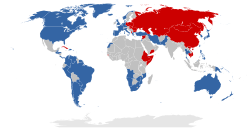Second World

The Second World was one of the "Three Worlds" formed by the global political landscape of the Cold War, as it grouped together those countries that were aligned with the Eastern Bloc of the Soviet Union. This grouping was directly opposed to the First World, which similarly grouped together those countries that were aligned with the Western Bloc of the United States. It included communist states that were originally under the Soviet sphere of influence, though some eventually broke away from the Soviet ideology (e.g., Yugoslavia's split and China's split) to develop their own path as socialist states while retaining their communist governments. Most communist states remained under Soviet influence until the Revolutions of 1989. In 1991, upon the dissolution of the Soviet Union, only five communist states remained: China, Cuba, Laos, North Korea, and Vietnam. Though the terms "First World" and "Third World" continue to see present-day relevance in colloquial speech, albeit with a repurposed definition, the term "Second World" is obsolete outside of a Cold War context.
Concept
[edit]The concept of "Second World" was a construct of the Cold War and the term is still largely used to describe former communist countries that are between poverty and prosperity, many of which are now capitalist states, such as Eastern Europe. Subsequently, the actual meaning of the terms "First World", "Second World," and "Third World" changed from being based on political ideology to an economic definition.[1] The three-world theory has been criticized as crude and relatively outdated for its nominal ordering, and some sociologists have instead used the words "developed", "developing", and "underdeveloped" as replacement terms for global stratification (which have been criticized as displaying a colonialist mindset);[2] nevertheless, the three-world theory is still popular in contemporary literature and media. This might also cause semantic variation of the term between describing a region's political entities and its people.[3]
Human development
[edit]The Three Worlds Model was used to rank the development of countries and their economies during the Cold War. First World countries were capitalist and industrial; they shared similar political and economic institutions, and retained influence over parts of the former colonial world. Second World countries advocated socialism and shared certain characteristics such as centrally planned economic systems, single-party states, and mainly medium income levels.[4] The First World and the Second World were competing for political and economic influence over developing nations known as the Third World.
The Human Development Index is an index used to rank countries and is quantified by looking at a country's human development such as life expectancy, education, and per capita income indicators. The scale is 0–1 and they are put into one of four categories; 0-.55 is low, .55-.70 is medium, .70-.80 is high and very high tops out at .80–1.0. The Second World countries from the Cold War era currently range from medium human development to very high human development in terms of HDI.[5]
Examples and decline in usage of term
[edit]Some examples of Cold-War definition Second World countries were Bulgaria, Czechoslovakia, Hungary, Mongolia, North Korea, Poland, Romania, the Soviet Union, and the German Democratic Republic.
The powerful economies of the West are still sometimes described as "First World", but the term "Second World" became largely obsolete following the collapse of the Soviet Union.[6]
See also
[edit]References
[edit]- ^ Andersen, Margaret L.; Taylor, Howard Francis (2006). Sociology: Understanding a Diverse Society. Thomson/Wadsworth. p. 250. ISBN 978-0-534-61716-5.
- ^ Silver, Marc (4 January 2015). "If You Shouldn't Call It The Third World, What Should You Call It?". NPR. Archived from the original on 1 April 2020. Retrieved 17 March 2018.
- ^ Giddens, Anthony (2006). Sociology. Polity. p. 42. ISBN 978-0-7456-3379-4.
second world countries communist.
- ^ Bankoff, Greg; Oven, Katie (24 June 2019). "What happened to the Second World? Earthquakes and postsocialism in Kazakhstan". Disasters. 44 (1): 3–24. doi:10.1111/disa.12362. PMID 31231813. S2CID 195327230. Archived from the original on 24 June 2021. Retrieved 24 June 2021.
- ^ "Second World Countries Population". World Population Review. 24 October 2019. Archived from the original on 21 February 2020. Retrieved 21 February 2020.
- ^ Andrews, Evan (22 August 2018). "Why are countries classified as First, Second or Third World?". History. A&E Television Networks. Archived from the original on 21 February 2020. Retrieved 21 February 2020.
